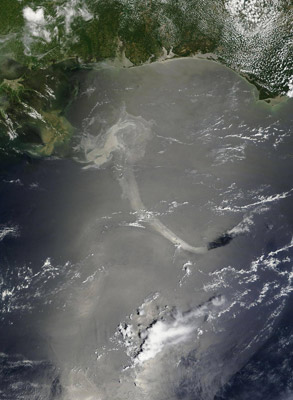Science and Health
At worst, oil spewed already could fill 102 gyms
(Agencies)
Updated: 2010-05-22 11:17
 |
Large Medium Small |
|
 The Gulf of Mexico and oil from the BP spill is seen in this NASA satellite photo taken on May 17, 2010. Fears that the huge Gulf of Mexico oil spill was spreading through ocean currents flared on May 18, 2010, after tarballs were found on Florida's Key West, while energy giant BP worked to capture more of the leaking crude. [Agencies] |
COVINGTON, Louisana - Day by day, the oil gushing into the Gulf of Mexico is adding up to mind-boggling numbers.
Using worst case scenarios calculated by scientists, a month's worth of leaking oil could fill enough 1 gallon (3.79 liter) milk jugs to stretch more than 11,300 miles (18,184 kilometers). That's more than the distance from New York to Buenos Aires, Argentina, and back. That's just shy of 130 million gallons (492 million liters).
If the government's best case scenario is used -- and only 5.25 million gallons (19.87 million liters) have spilled -- those milk jugs would cover a bit more than a roundtrip between New York and Washington. But the government is revising that number, with a team of scientists working around the clock to come up with a more realistic and likely higher figure.
Here's another way to think of just how much oil has gushed out since April 20: At worst, it's enough to fill 102 school gymnasiums to the ceiling with oil.
That's nothing compared to the vast expanse of the Gulf of Mexico, where there are 643 quadrillion gallons. Even under the worst case scenario, the Gulf has five billion drops of water for every drop of oil. And the mighty Mississippi River pours 3.3 million gallons (12.49 million liters) of new water into Gulf every second.
Under the rosiest scenario, little more than four gyms would be filled. That's how the National Oceanic and Atmospheric Administration visualizes oil spill volumes on one of its websites.
At worst, the amount of oil that has already spilled is a dozen times more than the Exxon Valdez disaster. At best, it's only half as bad. Realistically, it's probably somewhere in that huge middle in between.
"A lot of this is diffused now in deep layers," said Felder, who is coordinating a seven-volume scientific encyclopedia on the Gulf. "It's like it's under the rug. You can't see it on the surface, so it's kind of out of sight, out of mind. But it's not out of mind to most of the biologists who are concerned about its long-term effects."
There are many uncertainties about how much has spilled. It's not even clear if the leak began on April 20, when the rig exploded, or April 22 when the rig sank, or on April 24 when the Coast Guard first noticed two leaks.
Originally, BP and the federal government said 42,000 gallons (159,000 liters) were flowing per day. Then the number was upped to 210,000 (794,910 liters) and that's been the best case scenario, with calculations that the spill didn't start until April 24.
The best case scenario seems increasingly unlikely. On Thursday, BP acknowledged more oil than that is pouring into the Gulf. The company said its makeshift tube put in place to suck up the leak is siphoning 210,000 gallons (795,000 liters) a day into a barge -- the full amount of oil the company said was leaking. Yet, there's still lots of oil flowing out into the Gulf that can now be seen live on a webcam.
"Anyone can look at that and determine that even though it can't be metered or measured, it's significantly less than it was," said company spokesman Steve Rinehart. "That suggests pretty clearly that taking 5,000 barrels a day (210,000 gallons) out of that stream puts a real dent in it."
BP Chief Operating Officer Doug Suttles said Friday the tube is now sucking about 92,400 gallons (350,000 liters) of oil a day to the surface. It was much less than the figure the company used several times a day earlier, but Suttles said the higher number is the most the tube had been sucking up at any one time, while the lower number is the average over 24 hours.
Federal officials acknowledge their 210,000 gallons(795,000 liters)-a-day figure for the total amount spilling needs to be revised. NOAA director Jane Lubchenco said the old estimate was based on a long-held international scientific formula based on surface slick observations. But the way this oil slick changed makes that calculation no longer useful, she said.
The worst-case scenario is based on the upper end of broad estimates from several scientists for the daily flow rate of the leak based on video observation -- somewhere between 840,000 gallons (3.17 million liters) a day and 4.2 million gallons (15.9 million liters) a day.




